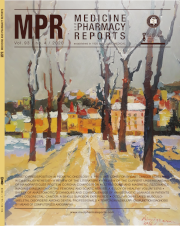Temporomandibular dysfunction diagnosis by means of computerized axiography
DOI:
https://doi.org/10.15386/mpr-1754Keywords:
temporomandibular disorder, disk displacement, axiographyAbstract
Background and aims.The objective of this study was to evaluate the accuracy of the CADIAX Compact 2 axiograph in confirming the presumptive clinical diagnosis of temporomandibular dysfunction, established according to the muscular-articular clinical examination.
Methods. A retrospective analytical study was carried out on 50 patients, aged between 21 and 62 years, 31 women and 19 men. A clinical diagnosis was established after masticatory muscles, temporomandibular joints and mandibular border limit movements were assessed. During the same day a computerized axiography (Cadiax Compact 2, Gamma, Vienna, Austria) was performed in order to confirm the diagnosis.
Results. The study had a sensitivity of 100%, which means that the CADIAX device detected all clinically positive patients. On the other hand, the specificity of the study was 74%, representing the percentage of patients negatively diagnosed by CADIAX device out of the total number of patients clinically diagnosed as negative. The 88% accuracy shows the proportion in which the CADIAX device provides a diagnosis equal to the clinical one.
Conclusions. Of all the methods for investigating temporomandibular joint dysfunction, axiography is less invasive, does not irradiate the patient, it is relatively easy to use and it offers functional information about the TMJ function.
Downloads
Published
How to Cite
Issue
Section
License
The authors are required to transfer the copyright of the published paper to the journal. This is done by agreeing to sign the Copyright Assignment Form. Whenever the case, authors are also required to send permissions to reproduce material (such as illustrations) from the copyright holder.

The papers published in the journal are licensed under a Creative Commons Attribution-NonCommercial-NoDerivatives 4.0 International License.

